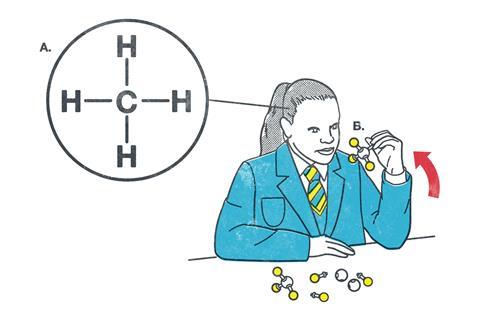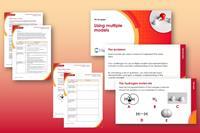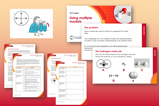Use models in your teaching to help students learn how to find solutions

In science, as in everyday life, there are many problems to solve. As science teachers, we use models all the time in our lessons, not just because they are explicitly mentioned in exam board specifications, but also because they help make abstract concepts more concrete. How do we help our students use models to problem solve in their science education?
Problem solving in everyday life
As a starting point, we can link models and problem solving to everyday life. In class, a student can successfully neutralise an acid using an alkali. We can gain student buy-in by applying this to situations outside the classroom, for example the need to brush our teeth.
Introduce routines around problem solving to motivate students
Taking it further, we can use their classroom experience of models when thinking about future careers. We can emphasise that problem solving is a fundamental skill in all jobs. We can embed the idea that problem solving isn’t simply something being learned in the classroom. Rather, it is a skill that will help them be successful in their later lives. To help them understand this concept, ask students to name a job and then explain how problem solving would be successfully used in that job.
Introduce routines around problem solving to motivate students into believing they have a strategy to attempt a task. Teach your students to use a textbook if they’re stuck. Teach them how to use the contents and index pages. This reinforces a skill that encourages independence and will benefit them if they run out of mobile data.
Promote engagement with students needing more encouragement by using a simple rhyme and choral response: ‘What do we do if we’re stuck?’ – ‘We look in a textbook’. If students find a task too hard and can’t solve the problem, motivation will fall and possibly lead to behavioural issues. While this approach needs a big input of teacher direction to begin with, over time the skill will embed.
-

Download this
Evaluate multiple models activity, for age range 14–16
Enhance your learners' skills interpreting and evaluating models with this set of examples showing a hydrogen molecule.
Download the teacher notes as MS Word or pdf, slides as PowerPoint or pdf and student worksheet as MS Word or pdf.
Download this
Multiple-models activity, for age range 14–16 years
Enhance your learners’ skills interpreting and evaluating models with this set of examples showing a hydrogen molecule, including classroom slides and a worksheet.
Download the activity from the Education in Chemistry website: rsc.li/3x7j2KW
Using models
While models are scattered throughout the curriculum, there are some best bets of where they routinely apply. When discussing JJ Thomson’s plum pudding model, students could choose a different model that represents the same idea, for example, a chocolate chip cookie. After a chromatography practical, students can be encouraged to identify an unknown substance based on different Rf values.
Acronyms are a useful model that students can learn to apply to similar questions. For example, to aid students in successfully drawing covalent bonding, introduce them to GROSO:
- group number
- required shared pairs
- overlap circles
- shared pairs drawn in
- other outer electrons
Acronyms are a useful model that students can learn to apply to similar questions. For example, to aid students in successfully drawing covalent bonding, introduce them to GROSO: group number; required shared pairs; overlap circles; shared pairs drawn in; other outer electrons.
Initially, this would need lots of practice and quick checks using mini whiteboards. Once the routine is embedded though, students can take this model and apply it to other covalent questions.
Worked examples also support students by providing a scaffold of how to answer a question. By referencing a completed question, students can attempt a question by following the steps.
More recommended resources
- Use Johnstone’s triangle to help learners of all ages and stages model their thinking.
- Our online Problem solving tutor will help your 16–18 learners to structure and develop their problem solving skills in quantitative chemistry.
- Find out how to use post-16 models to inform 14–16 understanding.
- Show your students how models can help to predict reactions and influence the taste and texture of chocolate and biscuits, by sharing a profile of food scientist, Robert.
More recommended resources
- Use Johnstone’s triangle to help learners of all ages and stages model their thinking: rsc.li/3mLA282
- Our online Problem solving tutor will help your 16–18 learners to structure and develop their problem solving skills in quantitative chemistry: rsc.li/3DJRJtG
- Find out how to use post-16 models to inform 14–16 understanding: rsc.li/3HYxHy6
- Show your students how models can help to predict reactions and influence the taste and texture of chocolate and biscuits, by sharing a profile of food scientist, Robert: rsc.li/3RCMMZl
Focusing on problem solving is also a brilliant opportunity to work with other departments. If multiple departments are using the same routine, students are more likely to commit this to long-term memory, thus reducing cognitive load.
The Ofsted research review into science contains a section on coherence between the mathematics and science departments describing how to share similar language around tackling equations. If students can problem solve in maths, we can show them how to carry that skill across by using the same method in science. Many maths departments teach the balance method to solve equations. You can apply this to many chemistry calculations, such as titration.
The Ofsted research review into science contains a section on coherence between the mathematics and science departments describing how to share similar language around tackling equations (rsc.li/3Yx4yjf). If students can problem solve in maths, we can show them how to carry that skill across by using the same method in science. Many maths departments teach the balance method to solve equations. You can apply this to many chemistry calculations, such as titration.
By using these strategies and questions with our students, we can teach them the importance of problem solving. These are skills, once learned, that students can carry with them for future success.

This article is part of our Teaching science skills series, bringing together strategies and classroom activities to help your learners develop essential scientific skills, from literacy to risk assessment and more.














No comments yet